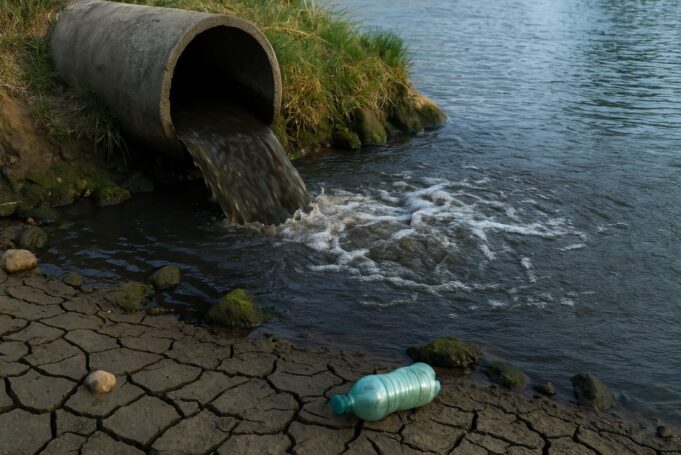Water is essential to life…the good old H20 – yet the pollution of this critical resource poses serious threats to human health.
Harmful contaminants often find their way into water supplies, affecting millions of people worldwide. From severe illnesses to chronic conditions, the health impacts of water pollution can be both immediate and long-lasting.
England’s water pollution crisis has reached a new low. The Environment Agency’s latest data reveals that serious pollution incidents by water companies have surged 60% in just one year, marking the highest levels on record. With 2,801 pollution incidents reported in 2024—up from 2,174 in 2023—the situation exposes systemic failures across the industry and regulatory bodies alike.
This dramatic increase isn’t just a number on a spreadsheet. It represents raw sewage flowing into rivers where communities swim, fish, and source drinking water. The 75 incidents classified as posing “serious or persistent” harm to fisheries, drinking water, and human health represent a 60% jump from the previous year’s 47 incidents.
The Public Accounts Committee didn’t mince words, calling the pollution levels “woeful.” Their assessment reflects growing public frustration with an industry that seems unable to protect the waterways it’s entrusted to safeguard.
Below, we’ll explore how specific pollutants impact the human body and highlight why access to clean water is vital for overall health.
The Pollutants and Their Harmful Effects
Water pollution encompasses a variety of harmful substances that contaminate our water supplies. These include heavy metals, pathogens, and chemicals—all of which pose unique threats to human health.
Heavy Metals
Toxic heavy metals such as lead, arsenic, and mercury are frequently detected in polluted water. Lead exposure, even at low levels, can have devastating consequences, particularly for children. It impairs brain development, reduces IQ, and can lead to behavioral issues. Long-term exposure in adults might cause high blood pressure and kidney damage.
Arsenic, commonly found in groundwater, is another silent threat. Chronic arsenic poisoning can cause skin disorders, a weakened immune system, and—most concerning—an increased risk of cancers, particularly of the skin, bladder, and lungs.
Mercury, often associated with industrial pollution, primarily affects the nervous system. Pregnant women exposed to mercury in drinking water risk developmental problems for their unborn children, including cognitive impairments and motor skill deficits.
Pathogens
Pathogens like bacteria, viruses, and parasites enter water sources through untreated sewage, agricultural runoff, or animal waste. One of the most notorious examples is Escherichia coli (E. coli), which can cause severe gastrointestinal distress, including diarrhea, vomiting, and abdominal cramps.
Long-term effects of waterborne pathogens include malnutrition and weakened immunity, particularly in developing nations where access to sanitation is limited. Cholera outbreaks, caused by the bacterium Vibrio cholerae, highlight how contaminated water can trigger community-wide health crises.
Industrial and Agricultural Chemicals
Chemicals from industries and farmlands—such as pesticides, herbicides, and nitrates—pose both immediate and cumulative health risks. For example, excessive nitrates in water, often resulting from fertilizer runoff, can interfere with oxygen transport in the blood, a condition known as methemoglobinemia or “blue baby syndrome.”
Pesticides and other hazardous chemicals are linked to endocrine disruption, which can affect hormone balance. Long-term exposure may also lead to cancers, reproductive challenges, and developmental disorders in children.
Short-Term vs. Long-Term Health Impacts
The health effects of water pollution are twofold: acute and chronic. Short-term exposure often leads to rapid onset symptoms, such as gastrointestinal upset from pathogens or skin irritation due to exposure to hazardous chemicals.
Long-term exposure, however, is more insidious, contributing to organ damage, cognitive decline, or a heightened likelihood of chronic diseases, including cancer and diabetes. Extremely vulnerable populations, including children, pregnant women, and the elderly, face amplified risks with devastating consequences for their well-being.
The Urgency of Clean Water
Safe, clean water is fundamental to human survival and health. It hydrates our bodies, supports organ functions, and prevents disease. Yet, water pollution jeopardizes this precious resource, leaving millions reliant on unsafe supplies. Addressing water pollution requires stricter regulations, technological solutions for water treatment, and global effort to ensure clean water is accessible to all.
By tackling water pollution head-on, we protect not only the planet but also our health—preserving the quality of life for future generations. Clean water isn’t a luxury; it’s a necessity for survival and a fundamental component of a healthier, more resilient society.
Got a story? Email holly@harleystreetcommunications.co.uk













